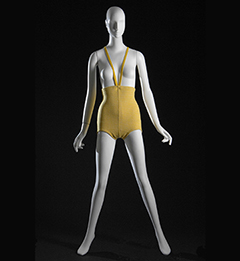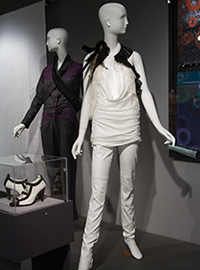
 Vivienne Tam, suit, black and white polyester in checkerboard pattern of "Mao" portraits, 1995, USA, gift of Vivienne Tam.
Vivienne Tam, suit, black and white polyester in checkerboard pattern of "Mao" portraits, 1995, USA, gift of Vivienne Tam.
Futuristic fashions by designers such as André Courrèges and Pierre Cardin captured the mood of the Cold War era and the space race. Sexual liberation and youthful exuberance were expressed by designer Rudi Gernreich, who believed that his fashions, particularly his famous "Monokini" topless bathing suit, were a form of social commentary. Rebellious "hippie" anti-fashion of the 1970s channeled antiwar sentiment by adopting counterculture iconography—the peace sign, for example. Meanwhile, the wearing of pants by women became a symbol of modernity and the women’s liberation movement. Designer Yves Saint Laurent declared: "Modern woman is a woman in pants."
IN THE NEWS -
DFR: Daily Fashion Report, July 10
Designs On Society: Fashion & Politics
Fashion in Politics, July 16
They Beat Us To It...
Fashion/Museum, September 8
Report from NYC: "Fashion and Politics"
Sarah Palin's "Funny Shoes" Are at the FIT Museum
WWD, July 9
'Fashion and Politics' Exhibit Opens at FIT
"The Most Fashionable Museum
in
New York City."
 Rudi Gernreich, "Monokini" topless bathing suit, yellow and white wool, 1964, USA, gift of Rita Watnick and Michael Stoyla.
Rudi Gernreich, "Monokini" topless bathing suit, yellow and white wool, 1964, USA, gift of Rita Watnick and Michael Stoyla.As the twentieth century progressed, the use of political and social imagery in fashion became increasingly explicit, addressing such issues as gay rights, AIDS, environmentalism, and global politics. Vivienne Tam’s controversial Mao collection of 1995 used a highly charged propagandist image—the face of Communist leader Mao Zedong—to comment on Chinese political history.

NOIR halter top and leggings, organic Ugandan cotton and leather, spring/summer 2009, Denmark, gift of NOIR.
Many contemporary designers are now using fashion as a medium for raising political, social, and environmental awareness. In light of the 2008 U.S. presidential campaigns, French designer Jean-Charles de Castelbajac paid homage to then-candidate Barack Obama with a sequin jersey minidress emblazoned with Obama’s likeness. "I made it because for me, Barack Obama is the most charismatic leader in politics today," he explained. "He is incarnate of hope, changes, and youth." The Danish fashion brand NOIR works with sustainable materials and fair-trade practices to blend luxury and sophistication with social responsibility. Mexican fashion designer Carla Fernández collaborates with indigenous communities to create jobs for local artisans and preserve traditional crafts. These designers’ approaches are varied, but all demonstrate fashion’s continued ability to articulate both the concerns and aspirations of our society.
